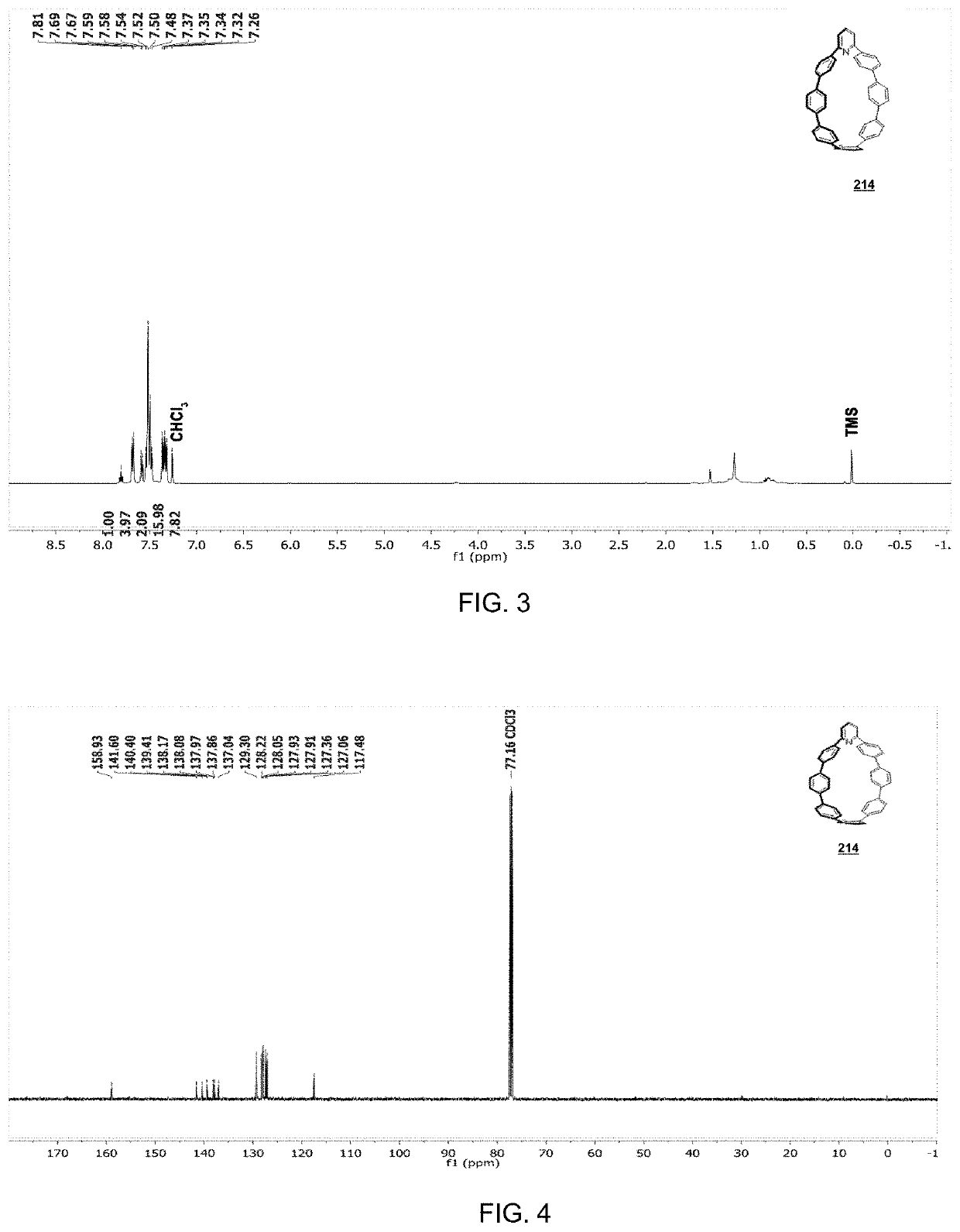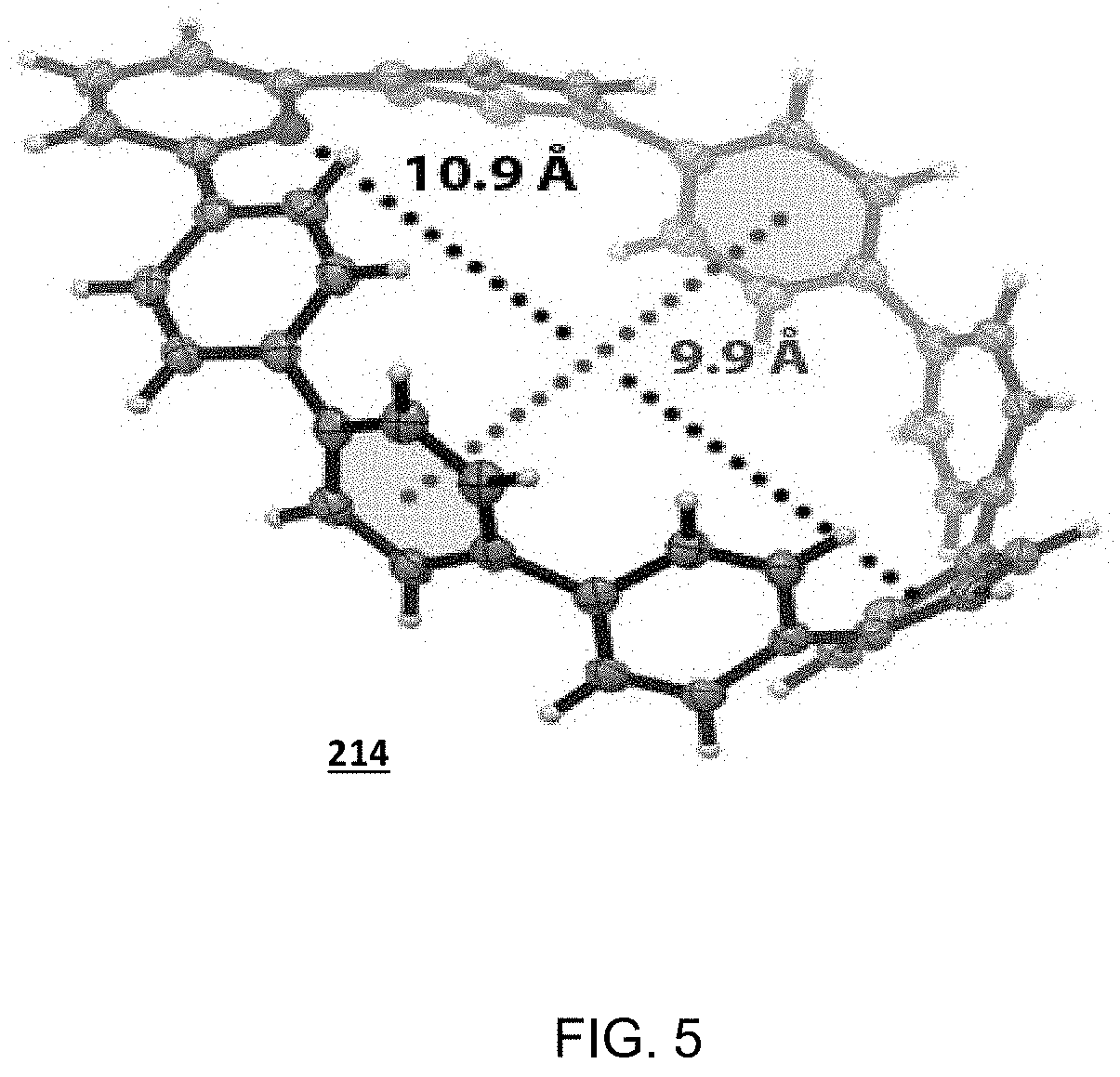Nanohoop compound embodiments comprising meta-substitution and molecular systems comprising the same
a technology of nanohoop compounds and molecular systems, which is applied in the direction of fluorescence/phosphorescence, group 3/13 element organic compounds, instruments, etc., can solve the problems of limited examples and underdeveloped synthetic methods for obtaining interlocked structures
- Summary
- Abstract
- Description
- Claims
- Application Information
AI Technical Summary
Benefits of technology
Problems solved by technology
Method used
Image
Examples
example 1
[0167]
[0168]To a flame-dried 2 L round bottom flask equipped with a stir bar, compound 210 (2.10 g, 1.33 mmol, 1.00 equiv.), 2,6-dibromopyridine (0.330 g, 1.40 mmol, 1.05 equiv.), and Pd SPhos GII (0.0958 g, 0.133 mmol, 0.10 equiv.) were added. The flask was evacuated and back-filled with N2 five times, followed by addition of 1,4-dioxane (700 mL). This solution was then vigorously purged with N2 for 30 minutes at which point it was then placed into an 80° C. oil bath for 30 minutes. At this point, an aqueous solution of 2M K3PO4 (70.0 mL, 35.0 mmol, 26.3 equiv.) was added, quickly turning the solution to a bright yellow. The reaction was monitored until all starting material was consumed (typically 1 hour), at which point the solution was allowed to cool to room temperature. After removal of the solvent via rotary evaporation, the resulting yellow / brown oil was extracted with DCM (3×75 mL), followed by washing of the combined organic phases with H2O (3×100 mL), brine (1×100 mL), an...
example 2
[0169]
[0170]To a flame-dried 100 mL round bottom flask equipped with a stir bar, compound 212 (0.360 g, 0.257 mmol, 1.00 equiv.) was added, followed by THF (20 mL). To this solution, tetrabutylammonium fluoride (TBAF) (1 M in THF, 2.57 mmol, 2.58 mL, 10.0 equiv.) was added, resulting in a tan-colored suspension. After stirring for 45 minutes, THF was removed via rotary evaporation, followed by addition of H2O (20 mL) resulting in a white precipitate. The white solid was collected via filtration, washed with H2O (50 mL), DCM (5 mL) and was then transferred to a flame-dried 100 mL round-bottomed flask with stir bar. After addition of THF (20 mL), H2SnCl4 was added dropwise, turning the colorless solution to a bright orange over 20 minutes. This was then allowed to stir for 45 min, at which point aqueous 1M NaOH (5 mL) was added, quickly turning the solution from bright orange to bright yellow. The THF was removed via rotary evaporation, followed extraction of the resulting yellow / oran...
example 3
[0172]
[0173]To a flame-dried 25 mL flask equipped with a stir bar, nanohoop compound embodiment 214 (11.7 mg, 0.0192 mmol, 1.00 equiv.), Cu(MeCN)4PF6 (6.4 mg, 0.0184 mmol, 0.96 equiv.), azide 220 (0.115 g, 0.192 mmol, 10.0 equiv.) and alkyne 218 (0.104 g, 0.192 mmol, 10.0 equiv.) were added. The flask was then evacuated and refilled with N2 for about five times. A septum was then placed on the flask, followed by the addition of 5 mL DCM. The reaction was followed with TLC and allowed to stir until complete consumption of azide 220 or alkyne 218. At this point, the reaction was quenched with an NH3-EDTA (2 mL) and then allowed to stir for 10 minutes. The layers were separated, followed by additional washing of the aqueous phase with DCM (2×20 mL). The combined organic phases were washed with H2O (3×20 mL), and brine (1×20 mL), and dried over sodium sulfate to give a bright yellow solid, which after chromatography (50% diethyl ether / hexanes, SiO2), yielded the desired triazole-contain...
PUM
| Property | Measurement | Unit |
|---|---|---|
| temperature | aaaaa | aaaaa |
| temperature | aaaaa | aaaaa |
| HOMO-LUMO oscillator strength | aaaaa | aaaaa |
Abstract
Description
Claims
Application Information
 Login to View More
Login to View More - R&D
- Intellectual Property
- Life Sciences
- Materials
- Tech Scout
- Unparalleled Data Quality
- Higher Quality Content
- 60% Fewer Hallucinations
Browse by: Latest US Patents, China's latest patents, Technical Efficacy Thesaurus, Application Domain, Technology Topic, Popular Technical Reports.
© 2025 PatSnap. All rights reserved.Legal|Privacy policy|Modern Slavery Act Transparency Statement|Sitemap|About US| Contact US: help@patsnap.com



